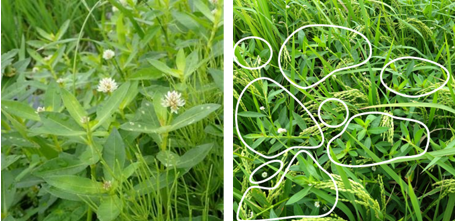NARO, in collaboration with the Chiba Prefectural Agriculture and Forestry Research Center and the Kanagawa Prefectural Agriculture Technology Center, has developed three systems of sequential application of herbicides to control alligator weed (Althernanthera philoxeroides), an invasive alien species that poses a significant challenge in transplanted rice fields. This systematic herbicide approach effectively suppresses alligator weed growth during rice cultivation. When applied consistently for two consecutive years, this method can eliminate alligator weed even in heavily infested rice fields by targeting its below ground structures responsible for vegetative reproduction and overwintering. This breakthrough is expected to significantly reduce weed-related damage and prevent further spread of alligator weed in rice-growing regions.
Overview
Alligator weed is a perennial weed classified as an invasive alien species, which invades and establishes itself in rivers, waterways, and rice paddies. First detected in Japan in 1989, it has since spread to 26 prefectures south of the Tohoku region as of December 2024.
This weed propagates vegetatively through stem and root fragments, including nodes. When it invades rice paddies, it competes with rice plants, reducing yields and obstructing harvesting operations. In addition, after plowing, fragments containing regenerating nodes can disperse through irrigation channels, further spreading the infestation. While alligator weed can overwinter in warm regions or water, in frost-prone areas, its above-ground parts typically die off by December, leaving below ground stems and roots as the primary overwintering structures. Because of its resilience and ability to spread rapidly, early intervention in infested fields and measures to prevent further expansion are essential. However, effective control methods for alligator weed in rice paddies had not been developed until now.
In collaboration with the Chiba Prefectural Agriculture and Forestry Research Center and the Kanagawa Prefectural Agriculture Technology Center, NARO has identified effective herbicides and their optimal application timing, leading to the development of a systematic herbicide treatment method for controlling alligator weed. This approach utilizes a pyraclonil-based herbicide and a florpyrauxifen-benzyl-based herbicide applied at critical growth stages. A pyraclonil-based herbicide is applied immediately after rice transplanting. Approximately 20 days after transplanting, when the alligator weed begins to regenerate and reaches a height of 5 cm, a florpyrauxifen-benzyl-based herbicide is applied. Alternatively, about 40 days after transplanting, when the alligator weed is 35 cm or shorter, the florpyrauxifen-benzyl-based herbicide is applied. This method effectively reduces alligator weed growth to less than 10% of conventional levels without the need for manual weeding during the rice growing season. In addition, two consecutive years of sequential application can eliminate below ground stems and roots, preventing regrowth in previously infested fields.
By preventing the formation of propagules, this technology not only mitigates the impact of alligator weed in rice fields, but also helps prevent its further spread through irrigation systems. Its implementation is expected to significantly reduce weed damage in rice production and provide a sustainable solution for managing this invasive species.


Publications
Ihara et al. (2022) Effects of herbicides used for paddy rice and paddy levees on alligator weed (Alternanthera philoxeroides). J. Weed Sci. Tech. 67 (1) 1-12. (In Japanese)
Ihara et al. (2024) Sequential application of herbicides for Alternanthera philoxeroides in transplanted rice fields to reduce below-ground propagule. J. Weed Sci. Tech. 69 (1) 8-18. (In Japanese)
Funding
This research was conducted as part of the project commissioned by the Ministry of Agriculture, Forestry and Fisheries (MAFF) under the"Development of management strategies for invasive alien species causing damage to agriculture" (JPJ007966). Portions of the research outcomes have been published in collaboration with MAFF and are available on its website under "Measures to eradicate alligator weed".
| For Inquiries |




